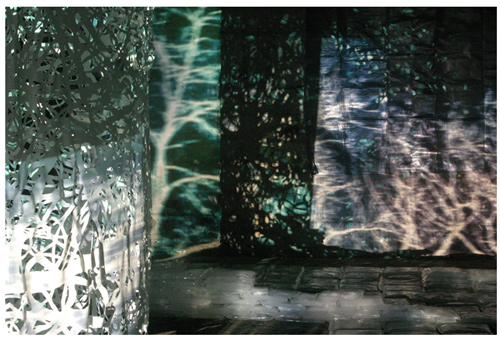Text formatting example page
Below is an excerpt from a sample article with citations and footnotes according to the standards of the Chicago Manual of Style. We recommend that you check the online version of the Chicago Manual of Style for the most up-to-date formatting guidelines.
Hover over areas with a red underline to see detailed instructions.
...
There are many analogies for this sum of dichotomies. But, the one that best encapsulates Pien's installations (and, in fact, the totality of his work) is that of the Grotesque. "Its appearance, however, is not sudden, but insidious. The familiar world is never wholly absent, but always on notice of dismissal." (Harpham 1976, 462)In parentheses, list the author's last name and year of publication with no comma in between. Then place a comma and cite the page number. For, the grotesque is the most dubious of signs, whose existence is dependent upon its slipperiness and unapologetic periphery---Use 3 hyphens to indicate an em dashthe fluid slope of a paradoxical aesthetic.
Pien's 2006 installation Witching Hour, a one-room installation held at Off the Map Gallery in Toronto, is exemplary of this elusive behaviour. (fig. A)For photographs or illustrations, use the abbreviation for figure, 'fig.' in parentheses, followed by an alphabetic character, beginning with the letter 'A'. It is an abundant nowhere. A utopian space [1]Use a pair of square brackets and chronologically ascending numbers for footnotes. See the NOTES section below for formatting the footnote itself.. Ornamentally bare. Like a gothic caesura held indefinitely by the conductor of a baroque orchestra.
A synopsis of the room might go: A glowing, sinewy temple standing in a technicolor forest, floating in the black abyss of surreality. The edges of the room seeming to disappear in the darkness of a vignette or a memory. Two projectors on opposite walls are the /only/Place forward-slashes before and after words that are meant to be italicized for emphasis. light sources. Images of trees diffuse over three cut-paper sculptures suspended from the ceiling. They paint the walls with fuzzy shadows and pixelated branches. In the center of the room is the largest of the sculptures; a cylindrical "tapestry" made of layers of interlacing cut-paper (Pien 2005)For citations of web content or other media where there are no page numbers, listing the author's last name and year of post/publication is sufficient. Please note: the citation should come at the end of the sentence even if the quotation is well before that.. There is a remarkable iridescence on the surface of the tapestry from the projections, and it only becomes apparent why as the viewer gets closer; a thin layer of ice coats the entire structure and reimagines the materiality of paper in a supernatural light.
These traits combined with its craftsmanship make for an exquisite object: Delicate. Sharp. Complex. Yet, it is also disturbing; the intricacy of its web pattern resembling a kind of animal--Use 2 hyphens to indicate an en-dashplant, its vascularity creating such an optical richness that its surface reads somatically. The juxtaposition of ice on paper transforming its structurally fluid properties into a definitive armature.
WORKS CITEDYour works cited section should immediately follow the end of your text. Sources should be listed in alphabetical order with the first line flush-left and subsidiary lines indented.
Harpham, Geoffrey, "The Grotesque: First Principles". The Journal of Aesthetics
and Art Criticism vol. 34, no. 4 (1976): 461-468.
Pien, Ed, "Statement," 2005, accessed on 16 March 2011,
http://www.dehuman.com/pien.html
NOTES
1.List footnotes in a separate list, following your works cited section at the end of your document. Place the corresponding number to where it appears in your document at the beginning of each note. Etymologically, "utopia", which is comprised of the Greek ou (not) and topos (place) means no-place. It is a historical and cultural construction that we associate this term with societal behaviours, such as equality, that lead to or produce an ideal world.
FIGURESCredits and information for figures, such as illustrations, photographs or diagrams, should be listed in a separate document and labeled in alphabetic order corresponding to where they appear in the text.
(A) Ed Pien, view of Witching Hour, 2006. Photograph by Antonia Lancaster.
 If possible, include thumbnails of each figure underneath its caption. Always send images as separate files. Never embed images within your text.
If possible, include thumbnails of each figure underneath its caption. Always send images as separate files. Never embed images within your text.